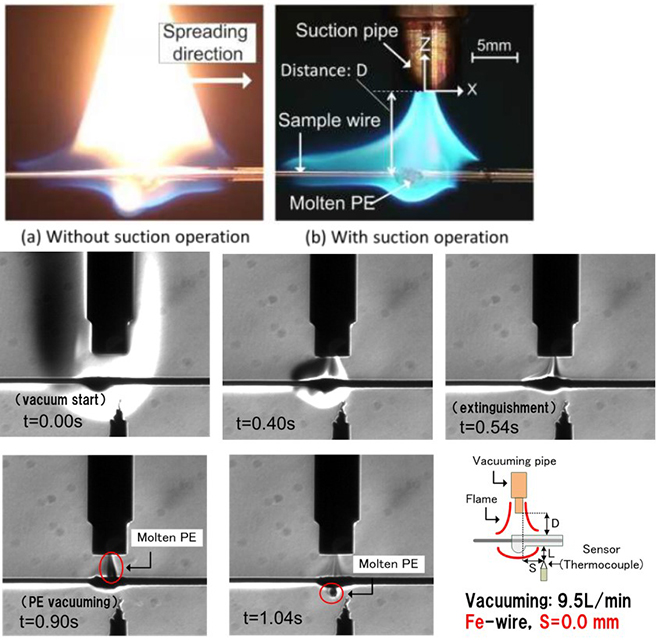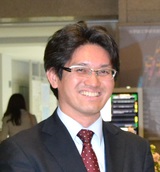
ここからコンテンツです。

New concept for a fire extinguisher usable in space
Vacuum Extinguishing Method – A Fire Extinguisher designed for use in space By Yuji Nakamura
Professor Yuji Nakamura and his research team at the Department of Mechanical Engineering of Toyohashi University of Technology, in collaboration with the Hokkaido and Shinshu Universities, has developed a new concept of fire extinguishing, named the Vacuum Extinguishing Method (VEM). VEM is based on a complete "inverse" operation of the conventional fire extinguishing procedure; It neutralizes the combustion by sucking the combusting material, along with the flames and the source of the combustion, into a vacuum chamber. This concept is advantageous for use in space, as it prevents the spread of harmful combustible material within the enclosed cabin.
At present, fire extinguishers used in spacecraft or space stations are mainly CO2-spraying gas extinguishers, although water mist was partially considered as an alternative. However, it must be noticed that the spraying type of extinguisher is not the best choice for the space-environment because of the limited volume of the cabin, resulting in the increase of CO2 concentration. It is, therefore, necessary to wear an O2 mask before actually being able to use the extinguisher, and the resulting delay allows the fire to grow. In addition, spraying CO2 gas toward the fire causes the combusting material and CO2 to scatter dangerously across the cabin. Cleaning up these emissions is very likely to cause considerable delay to the mission. Furthermore, the strain on the CO2 filter would necessitate frequent replacement; thus creating a need to bring substantial stocks of filters for longer space missions. Since these factors are not critical on earth, the research team focused their attention on the discovering the best solutions for fires in space.

VEM is a state-of-art concept newly proposed by the team lead by Professor Yuji Nakamura, which is basically a completely "inversion" of the standard procdeure for fighting fire. It basically uses a vacuum to suck the combusting material, along with the flames and the source of the combustion, into a vacuum container to be isolated, where it can be safely extinguished. Should this method be successful, it would negate the need for the time consuming step of putting on an an O2 mask, and so respond quickly dealing with the fire. In addition, any gas emissions would be effectively removed from the cabin and so reduce damage to the filter. Though this method sounds odd on earth, it may turn out to be the best solution for space.
Taichi Usuki, Prof. Yuji Nakamura’s former masters student from his time at Hokkaido University, investigated the feasibility of this concept and formulated the explanation of how it could be implemented. Three types of extinction modes were found and each extinction mode was controlled by a suction flow rate. The article summarizing this concept was accepted to be published in a special issue entitled "Spacecraft Fire Safety" in the prominent international journal Fire Technology.
The leader of the research team, Professor Yuji Nakamura, said, "The idea initially emerged through informal discussions with US researchers. Though it was simple enough to test and confirm the concept, it proved far more challenging to create a systematic study to demonstrate its performance and to formulate the performance based on a mathematical model. With the assistance of Mr. Usuki, and their collaborator Prof. Wakatsuki, the concept was confirmed and the complete testing device was successfully developed. Controlled vacuuming was introduced by an ejector system and all devices were activated with sensors in the test to substantially improve reproducibility. Fascinating flame suction images show the results and provide high quality images which show how the process should be modeled. At present, space agencies are wary of introducing this concept because a functioning device has yet to be developed and tested. However, we will continue to refine and share the concept".
The research team expects VEM to be adopted as a technique for future space missions. They note also that the technique would be applicable for extinguishing certain rare types of blaze, such as a metal powder fire, which can not easily be dealt with by the current generation of extinguishers. It is also expected to be useful for tackling fires in clean rooms, where the spray of fire-fighting agents could cause severe damage to the structure and equipment, and so render them unusable for a significant period.
In the future, if long-term space missions are to be viable, then fire safety strategy will require reconsideration. Moreover, because non-specialists such as newly recruited astronauts may in the future be involved in space travel, or even staying at a space hotel, the need for easy-to-use emergency devices becomes clear. This concept could eventually become the new standard for fire-fighting devices in space. Even for home use, a "new" vacuum cleaner may have special options with this kind of fire extinguisher. Sounds ridiculous? Maybe not.
This work was supported by Grants-in-Aid for Challenging Exploratory Research, The Ministry of Education, Science, Sports and Culture (No. 25560160).
Reference
Yuji Nakamura, Taichi Usuki, Kaoru Wakatsuki (2019). Novel Fire Extinguisher Method using Vacuuming Force Applicable to Space habitats. Fire Technology (special issue: Spacecraft Fire Safety),
https://doi.org/10.1007/s10694-019-00854-4
真空消火法(VEM) ― 宇宙環境での使用を目指した消火器の新しいコンセプト
By 中村 祐二
豊橋技術科学大学の中村祐二教授らの研究チームは、真空消火法という消火の新しい手法を提唱しました。真空消火法は、従来の消火法の「逆」の手順に基づいて行われるもので、炎や燃焼生成物、燃焼源そのものを真空室に吸い込み、火災空間をきれいにできます。この方法では、火災に伴い発生する有害な物質が広がるのを防ぐことができるため、閉鎖度の高い宇宙空間等での使用に適しています。
現在、国際宇宙ステーションで使用されている消火器は、主に二酸化炭素を噴射して消火させる仕組みを採用しています。しかしながら、対象室内は閉鎖度の高い狭い空間であり、消火により二酸化炭素濃度も上昇するため、消火活動を始める前に酸素マスクを着用する必要があります。この手順では消火活動開始に遅れが生じ、その間に火災が延焼して手遅れになる可能性があります。さらに、噴射式の消火方法では、炎が消せたとしても燃焼で生成した有害ガス成分等が室内に広がり、消火室内の現状復帰が遅れてしまいます。
このような問題を解決するため、中村教授らの研究チームはこれまでにない消火戦略を提案しました。それが、VEM(Vacuumed Extinguish Method)と呼ばれる真空消火法です。VEMは消火の操作がこれまでと全く逆で、(高圧を利用した噴射ではなく)真空にした箱への吸引を活用しています。具体的には、炎や燃焼生成物、燃焼源そのものを「まるごと」真空にされた箱内に吸引し、必要であればその中で消火します。この方法であれば、火災場で二酸化炭素ガス濃度が増えることがないため、消火活動前に酸素マスクを装着する時間は不要となり、火災による有毒ガスは直ちに火災発生空間から除去され、消火後の現状復帰が早まります。
研究チームはVEMが今後の宇宙ミッションにおいて次世代技術となることを期待していますが、適用先は宇宙に限りません。例えば、家庭や工場などで多用される粉末消火器は、精密機械があるクリーンルームや手術室等で用いると消火後に機械が使用できなくなる可能性があります。このような空間の消火活動にもVEMが役立つと期待できます。自宅の中でも消火薬剤を撒くのをためらわれることもあるでしょう。もしかすると、近い将来、消火機能のついた「次世代掃除機」が家の中で使われる日がくるかもしれません。
Researcher Profile

| Name | Yuji Nakamura |
|---|---|
| Affiliation | Department of Mechanical Engineering |
| Title | Professor |
| Fields of Research | Combustion/ Fire/ Scale Modeling/ Space Engineering |
ここでコンテンツ終わりです。
